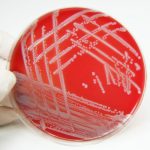 A staph infection is a group of infections caused by staphylococcus, which can result in anything from a minor skin infection to a serious infection that can affect the lungs, heart and blood. Although many staph infections can be treated, there are some that are antibiotic resistant, which are more harmful.
A staph infection is a group of infections caused by staphylococcus, which can result in anything from a minor skin infection to a serious infection that can affect the lungs, heart and blood. Although many staph infections can be treated, there are some that are antibiotic resistant, which are more harmful.
Antibiotic resistant staph infections are known as methicillin-resistant Staphylococcus aureus (MRSA). PVL-Staphylococcus aureus, too, is resistant to many common antibiotics, which can also kill off disease-fighting white blood cells and lead to reoccurring skin infections.
Advertisement
There are two types of staph infection: skin and soft tissue infections and invasive infections. Skin and soft tissue infections include:
- Boils
- Impetigo
- Cellulitis
- Skin abscess
- Folliculitis
- Wound infections
- Staphylococcus scaled skin syndrome (SSSS)
Invasive infections include:
- Septic arthritis
- Osteomyelitis
- Pneumonia
- Endocarditis
- Sepsis
- Toxic shock syndrome
Staph infection causes

One in three people carry the bacteria that can lead to staph infections harmlessly on their skin. Bacteria of this kind like to stay below the nose or the surface of the armpits and buttocks. The bacteria becomes problematic when it enters the body, either through a wound, insect bite or medical equipment, to name a few examples.
Staph infections can also be transmitted person to person in close proximity or by sharing contaminated objects like towels or toothbrushes. Contaminated food, too, can spread the bacteria, along with sneeze and cough droplets.
Anyone can develop a staph infection, but those with weakened immune systems, those who use medical equipment that is inserted (like a catheter), and those who experienced trauma to the skin causing an open wound, have the highest risk.
Staph infection symptoms
Symptoms of staph infections are dependent on what kind of infection it is. For example, if the bacteria affect the skin a boil may appear. If a person experiences toxic shock syndrome, they may encounter diarrhea, nausea, a rash, confusion, muscle aches and abdominal pain.
Always see your doctor immediately if you encounter a red painful area on your skin, pus-filled blisters or a fever.
Staph infection treatment

Mild staph infections may not require specific treatment and may go away on their own within a few days. In some other cases, antibiotic topical creams or pills may be prescribed or boils and blisters may be drained.
Invasive staph infections require hospital treatment as the body needs to be supported along with the treatment being administered.
When you are treating a staph infection ensure you are taking the necessary precautions to not spread the bacteria. Don’t share personal objects, regularly wash your hands, disinfect areas where you have been, cover your nose and mouth when coughing or sneezing and avoid close contact with others.
Natural treatment for staph infection
Tea tree oil: Tea tree oil works well as an antibacterial and can kill the viruses and bacteria, such as staph. It is important to note that tea tree oil should never be in direct contact with your eye as it can irritate it.
Coconut oil: Despite not being a true essential oil, coconut oil contains many nutrients and chemical compounds that can benefit overall health. It is believed that coconut oil can boost the immune system, which will help fight off the staph infection. It is important to make sure to get pure or virgin coconut oil as there exist many other types that carry additional unwanted chemicals.
Basil oil: This essential oil can be used for its health effects as well as in cooking. Superficially, French basil is best used through aromatherapy. It also works as a decongestant, antiseptic, muscle relaxant, and has anti-inflammatory properties, making it great for reducing pain caused by inflammation.
Frankincense: A great healing essential oil, Frankincense helps promote pain relief throughout the body. It is thought to work by blocking leukotrienes—substances that initiate inflammatory responses in the body. This essential oil can also act as a mild sedative, making it great for stress relief.
Ginger: This root spice has been long known for harboring many beneficial health effects when consumed, but its oil can also be used externally on your skin as well, thanks to ginger’s antibacterial and anti-inflammatory properties. Staph infection symptoms may find some benefit from its use.
Treat skin rashes and blisters: Helps to reduce pain and swelling due to staph infections.
- Using a clean wash cloth, soak it in warm water and compress against the rash.
- To prevent fluid accumulating in the affected region, elevate the painful or swollen area.
- It may be helpful to gently stretch stiff areas to prevent them from becoming more stiff.
- Wear loose and breathable clothing to prevent rash irritation.
- Avoid skin irritants that may inhibit the healing process. This includes body soaps, detergents, perfumes, and certain lotions.
- Speak to your doctor to get an expert opinion and to see if the use of soothing essential oils, such as lavender, may be beneficial.
Staph infection prevention tips
Advertisement
Staph infection prevention tips include:
 Regularly washing your hands
Regularly washing your hands- Keeping wounds well covered
- Changing tampons frequently and not leaving them in too long
- Not sharing personal items like toothbrushes
- Washing clothes and bedding in hot water
- Ensuring food is properly cooked
- Avoiding contact with those with a known staph infection
Following these tips can help increase your odds of successfully preventing a staph infection.
Share this information
